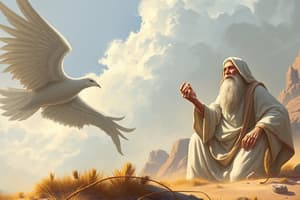Podcast
Questions and Answers
When was it written?
When was it written?
161-65 BC
What was the king's name?
What was the king's name?
Antiochus IV
What 5 things did the king do that made the people mad? (Select all that apply)
What 5 things did the king do that made the people mad? (Select all that apply)
- Desecrated the temple (correct)
- Auctioned off sacred Jewish positions (correct)
- Burnt copies of the Torah (correct)
- Drew up plans to annihilate Judaism (correct)
- Raised taxes (correct)
What was the reaction of the Jewish people?
What was the reaction of the Jewish people?
Who led the Jews in the Maccabean revolt?
Who led the Jews in the Maccabean revolt?
How many sons are there?
How many sons are there?
Which idea about life after death is introduced in this text?
Which idea about life after death is introduced in this text?
Which kind of responsibility does the sixth brother talk about?
Which kind of responsibility does the sixth brother talk about?
What does this text say about women and children?
What does this text say about women and children?
What language was the text originally written in?
What language was the text originally written in?
What is the main idea given on life after death?
What is the main idea given on life after death?
Flashcards are hidden until you start studying
Study Notes
Historical Context
- Written between 161-165 BC during the Maccabean revolt against Seleucid rule.
- Key figure in opposition to Jewish practices was King Antiochus IV.
Actions of Antiochus IV
- Raised taxes which burdened the Jewish population.
- Auctioned off sacred Jewish religious positions, undermining the authority of traditional leaders.
- Burnt copies of the Torah, a direct attack on Jewish law and tradition.
- Desecrated the temple, a significant religious symbol for the Jewish people.
- Planned to annihilate Judaism, intensifying his campaign against Jewish identity.
Jewish Response
- Responses varied among the Jewish people: some accepted Antiochus' rule, others chose to hide, while many died for their faith in defiance.
Maccabean Revolt Leadership
- The revolt was led by Matthaeus, an important figure in Jewish resistance.
Notable Figures
- The Maccabean revolt featured seven sons, whose stories illustrate the themes of faith and sacrifice.
Theological Developments
- The text introduces the concept of resurrection, suggesting hope in life after death.
- The sixth brother emphasizes individual responsibility in maintaining faith.
Suffering and Faith
- Highlights that women and children also endure suffering and can face martyrdom for their beliefs, expanding the narrative of sacrifice beyond male figures.
Language and Composition
- Originally written in Greek, reflecting the Hellenistic influences of the time.
Main Ideas on Life After Death
- Asserts that the just who endure hardships will experience restoration to life, reuniting with family in the afterlife, emphasizing the importance of perseverance in faith.
Studying That Suits You
Use AI to generate personalized quizzes and flashcards to suit your learning preferences.




